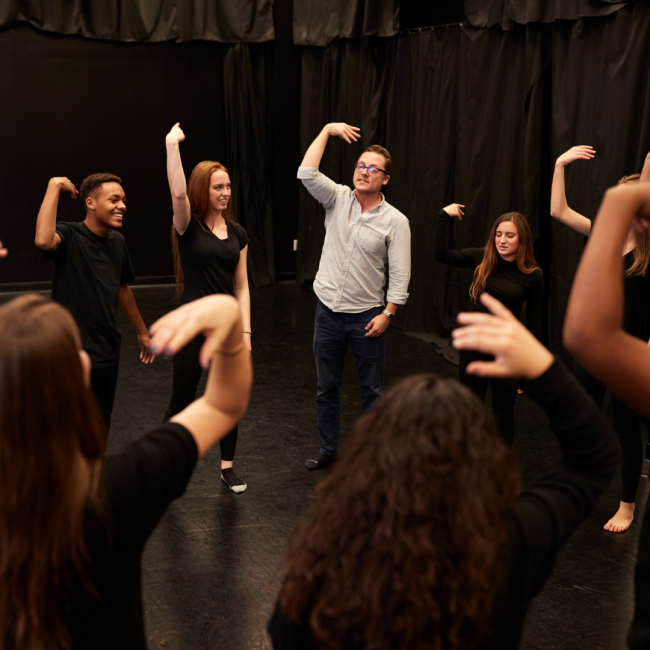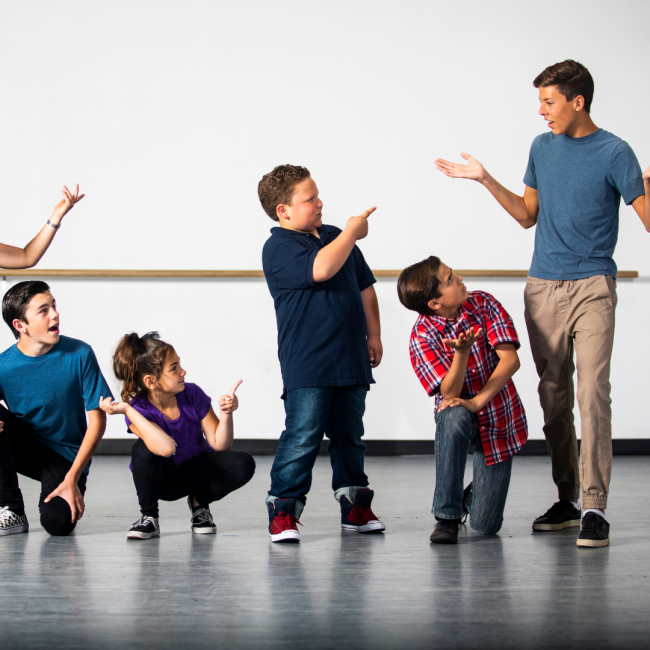High School Theatre Teaching / Classroom
Energize Your Drama Class: Whole Class Warm-Up Games
Alexandra Appleton | Last updated: July 09, 2024
Warm-up games are an essential part of any drama class, serving to break the ice, build group cohesion, and prepare students both mentally and physically for the creative work ahead. A well-chosen warm-up game can set the tone for the entire session, helping students to focus, loosen up, and foster a sense of community. Here, we explore a variety of whole-class warm-up games that drama teachers can incorporate into their lessons.
Why Do Warm-Up Games Matter?
Before diving into specific games, it’s important to understand the benefits of incorporating warm-up activities into your drama lessons:
- Enhance Focus: Games can help students transition from their previous activities and mentally prepare for the drama work ahead.
- Build Trust and Collaboration: Engaging in fun, low-stakes activities helps students to build trust with one another, which is crucial for effective ensemble work.
- Boost Energy Levels: Physical activities get students moving, helping to energize and invigorate the group.
- Foster Creativity: Creative games encourage students to think outside the box and explore new ideas in a playful environment.
Now, let’s explore some warm-up games that are sure to get your drama class moving and collaborating effectively.

1. Zip, Zap, Zop
Objective:
Enhance focus, quick thinking, and teamwork.
Instructions:
- Arrange students in a circle.
- One student starts by clapping and pointing at another student, saying “Zip”.
- The next student responds quickly by clapping and pointing at another student, saying “Zap”.
- The game continues with “Zop”, and then cycles back to “Zip”.
- Encourage students to maintain a quick pace to keep the energy high.
Variations:
- Add new words and actions, like “Bing” (jump in place) or “Bong” (spin around), to increase complexity.
- Reverse the order of the words to challenge students further.
2. Pass the Sound and Movement
Objective:
Promote listening skills, creativity, and group cohesion.
Instructions:
- Students stand in a circle.
- One student starts by making a unique sound and movement.
- The next student repeats the sound and movement, then creates their own to pass along.
- Continue around the circle until everyone has had a turn.
Tips:
- Encourage exaggerated and creative movements to make the game more dynamic.
- After one round, challenge students to pass the sound and movement without breaking the rhythm.
3. The Name Game
Objective:
Learn names, build community, and encourage active listening.
Instructions:
- Students stand in a circle.
- One student says their name and adds a gesture or movement that represents them.
- The group repeats the name and the gesture.
- Move to the next student, who says their name and gesture, and then the group repeats it.
- Continue until everyone has had a turn.
Variations:
- As a memory challenge, go around the circle again, having each student recall and perform another student’s name and gesture.

4. Count to 20
Objective:
Improve focus, patience, and non-verbal communication.
Instructions:
- Students stand in a circle, heads down and eyes closed.
- The goal is to count to 20 as a group, with only one person saying a number at a time.
- If two students speak at the same time, the count starts over.
- Achieve the goal without any planning or verbal cues.
Tips:
- Encourage students to listen carefully and be patient.
- Celebrate small achievements, such as reaching 10 without interruption.
5. Mirror Exercise
Objective:
Develop focus, observation skills, and empathy.
Instructions:
- Pair students up, facing each other.
- One student is the “leader” and the other is the “mirror.”
- The leader begins to move slowly, while the mirror tries to replicate the movements exactly.
- After a few minutes, switch roles.
Variations:
- Increase the challenge by having pairs move in a synchronized dance.
- Use this exercise as a trust-building activity by adding more complex movements.
6. Yes, Let's!
Objective:
Encourage spontaneity, collaboration, and positive affirmation.
Instructions:
- Students spread out in the space.
- One student suggests an action, like “Let’s pretend we’re climbing a mountain!”
- The group responds with enthusiasm, saying “Yes, let’s!” and then performs the action together.
- Continue with different suggestions, keeping the energy high.
Tips:
- Encourage imaginative and diverse suggestions.
- Use this game to introduce themes or elements of the day’s lesson.
7. Fruit Salad
Objective:
Improve listening skills, quick thinking, and physical coordination.
Instructions:
- Arrange chairs in a circle, one fewer than the number of participants.
- Assign each student a fruit (e.g., apple, banana, cherry) so that there are multiple students for each fruit.
- One student stands in the middle and calls out the name of a fruit.
- All students assigned that fruit must stand up and quickly switch places.
- The student in the middle tries to sit in one of the vacated chairs.
- The student left without a chair becomes the new caller and can call out another fruit or "fruit salad," which means everyone must switch places.
Tips:
- Encourage students to move quickly but safely.
- To add complexity, introduce more fruit names or categories.

8. Space Walk
Objective:
Increase spatial awareness, focus, and creativity.
Instructions:
- Students spread out evenly around the room.
- Instruct students to walk around the space, changing direction frequently to avoid collisions.
- Call out different prompts to change the style of walking, such as:
- Walk as if you’re moving through thick mud.
- Walk as if you’re on a tightrope.
- Walk like a robot.
- Walk as if you're on the moon.
- Continue to change the prompts to keep the exercise dynamic and engaging.
Variations:
- Introduce music and have students adjust their movements to the rhythm.
- Add obstacles or imaginary scenarios, such as walking through a crowded market or a windy day.
9. Energy Ball
Objective:
Enhance focus, imagination, and group energy dynamics.
Instructions:
- Students stand in a circle.
- One student starts with an imaginary energy ball, demonstrating its size, weight, and texture through their movements.
- The student "throws" the energy ball to another student, who catches it and changes its characteristics (e.g. making it heavier, lighter, or a different shape).
- The energy ball is passed around the circle, with each student modifying it before passing it on.
Tips:
- Encourage students to be creative with the energy ball's properties.
- Maintain a fast pace to keep the energy levels high.
10. Machine
Objective:
Foster collaboration, creativity, and physical coordination.
Instructions:
- One student steps forward and starts a repetitive motion with a sound, becoming part of an imaginary machine.
- Another student joins in, adding a complementary motion and sound.
- One by one, students add to the machine until everyone is participating.
- Once the machine is complete, encourage the group to synchronize and keep the machine running smoothly.
Variations:
- Challenge the group to create a machine that performs a specific function, like baking a cake or building a house.
- Introduce new elements, such as speeding up or slowing down the machine, or having parts of the machine break down and get repaired.
Conclusion
Whole-class warm-up games are a vital tool in a drama teacher’s toolkit, offering a myriad of benefits from fostering focus to building a sense of community. By incorporating these engaging activities into your lessons, you set a positive, energized tone that primes students for creative exploration and collaborative work. Remember to keep the atmosphere fun and inclusive, encouraging all students to participate fully. With the right warm-up games, you can transform your drama class into a dynamic, cohesive, and creatively charged ensemble.
For more ideas for warm-up exercises for younger children, check out our earlier blog post!
Last Updated: July 09, 2024

Alexandra Appleton
Writer, editor and theatre researcher